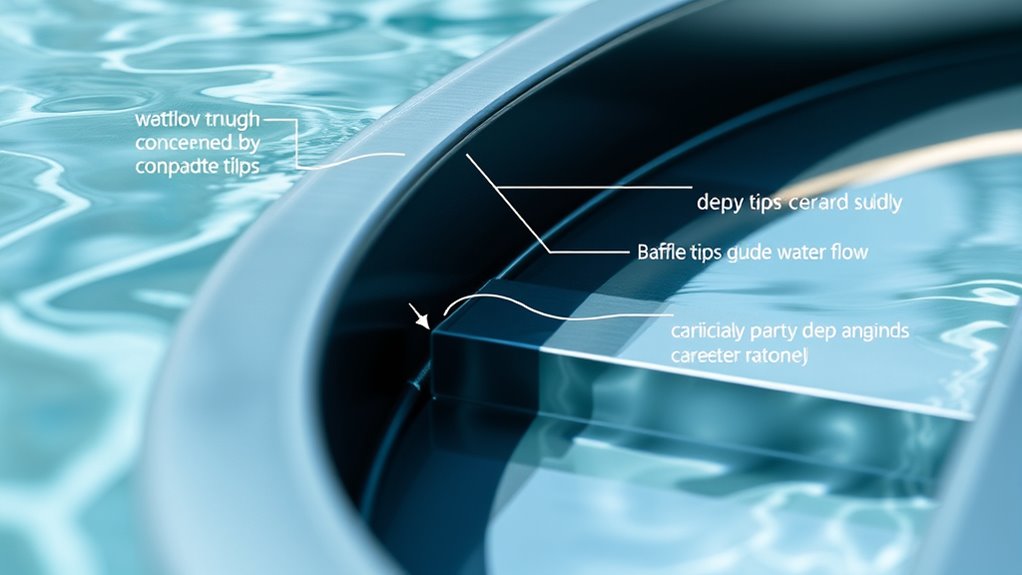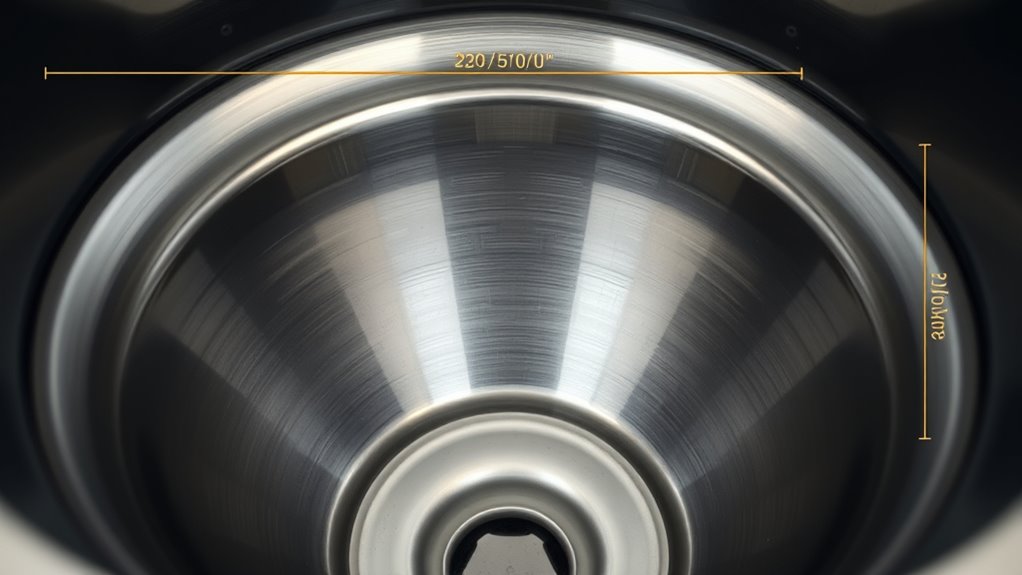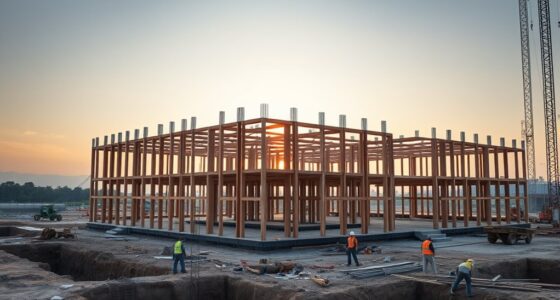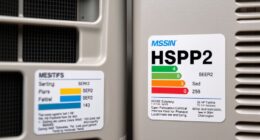To size your overflow trough effectively, start by determining the ideal depth that can handle peak water flow without spilling, considering maximum water levels plus a safety margin. Choose a width that matches expected water volume—wider for higher flows while avoiding waste. Place baffles strategically, using angles or curves to guide water smoothly and reduce turbulence. Properly sizing and designing your trough prevents overflow and damage; keep exploring for detailed tips to perfect your setup.
Key Takeaways
- Determine the maximum expected water level during peak flow and add a safety margin to set the optimal trough depth.
- Match trough width to expected water volume and flow rate to prevent overflow and ensure efficient drainage.
- Consider space constraints and system requirements when selecting trough depth and width for balanced capacity.
- Use strategically placed, angled, or curved baffles to guide water flow, reduce turbulence, and prevent splashing.
- Secure baffles firmly and adjust their height to optimize flow control and minimize overflow risks.
Determining the Optimal Depth for Your Overflow Trough

Choosing the right depth for your overflow trough is essential to guarantee it functions properly. You need enough depth to handle peak water flow without overflowing or causing backups. Consider the typical volume of water your system will encounter, especially during heavy rain or increased usage. A trough that’s too shallow may spill easily, while one that’s too deep can be unnecessarily bulky and harder to install. Think about your setup’s specific requirements and the space available. Measure the maximum expected water level and add a safety margin. This ensures the trough can handle sudden surges without overflowing or causing damage. Proper depth is critical for efficient water management and avoiding costly repairs or messes down the line. Additionally, understanding the water flow dynamics of your system can help optimize the trough’s size and placement for long-term effectiveness.
Selecting the Right Width for Effective Water Management

How can you guarantee your overflow trough effectively manages water flow? The key is selecting the right width. If it’s too narrow, water may overflow during heavy rain; too wide, and it wastes space and materials. To find the ideal width, consider your expected water volume, trough depth, and flow rate. Use the table below to guide your decision:
| Water Volume | Trough Width | Expected Flow Rate |
|---|---|---|
| Low | Narrow | Slow |
| Moderate | Medium | Steady |
| High | Wide | Fast |
| Very High | Extra Wide | Rapid |
Choosing the correct width ensures efficient drainage, minimizes overflow risk, and maintains structural integrity for your water management system. Proper sizing also supports maximized space and organization, helping you create a more efficient and clutter-free environment.
Baffle Placement and Design for Enhanced Flow Control

Proper baffle placement and design are essential for optimizing water flow within your overflow trough. Correctly positioned baffles guide water efficiently, reducing turbulence and preventing overflow issues. To improve flow control, consider these key points: 1. Place baffles at strategic intervals to create a smooth, even flow across the trough. 2. Use angled or curved baffles to direct water gently, minimizing splashing. 3. Ensure baffles are securely anchored to withstand water pressure and debris impact. 4. Adjust baffle height to balance flow speed and prevent water from bypassing the trough. Additionally, understanding the importance of support hours can help plan maintenance or adjustments during optimal times.
Frequently Asked Questions
How Does Overflow Trough Size Affect Water Quality?
Your overflow trough size directly impacts water quality by controlling water flow and preventing debris buildup. A properly sized trough guarantees efficient water movement, reducing stagnation where bacteria and algae can thrive. If it’s too small, it may overflow or clog, leading to contamination. Conversely, an appropriately sized trough maintains clean, well-oxygenated water, promoting a healthier environment for aquatic life and reducing the risk of water quality issues.
Can Overflow Troughs Be Customized for Specific Pond Sizes?
Yes, you can customize overflow troughs for specific pond sizes. When designing, you consider your pond’s dimensions, flow rate, and load to guarantee proper capacity. You may adjust the width, depth, and baffle placement to optimize water flow and prevent overflows. Customization helps maintain water quality and system efficiency, ensuring your pond stays balanced regardless of its size or unique conditions.
What Materials Are Best for Durable Overflow Troughs?
You should choose materials like high-density polyethylene, stainless steel, or concrete for durable overflow troughs. These materials embody strength and resilience, standing firm against weather and wear. Polyethylene offers flexibility and corrosion resistance, stainless steel provides sleek durability, and concrete ensures longevity and stability. By selecting these options, you create a reliable barrier that withstands the elements and time, ensuring your pond’s overflow system remains effective and long-lasting.
How Often Should Overflow Troughs Be Inspected or Maintained?
You should inspect and maintain your overflow troughs at least once a month to guarantee they function properly. Regular checks help you identify clogs, leaks, or damage early, preventing costly repairs or system failures. Keep an eye on water levels, baffle conditions, and overall cleanliness. Prompt maintenance allows you to address issues quickly, maintaining efficient operation and avoiding overflow problems that could impact your facility’s safety and performance.
Are There Environmental Regulations Impacting Overflow Trough Designs?
Environmental regulations can dramatically influence overflow trough designs, shaping how you build and maintain them. These rules are like a compass guiding you through sustainable practices, emissions limits, and water quality standards. You must stay updated and guarantee your troughs meet local, national, and even international standards. Ignoring these regulations risks hefty fines and environmental harm, so proactively design with compliance in mind. Your responsible approach protects ecosystems and ensures smooth operations.
Conclusion
By choosing the right depth, width, and baffle setup, you guarantee your overflow trough manages water efficiently. Proper sizing prevents overflow and promotes smooth flow, saving you time and effort. Are you ready to optimize your water management system? Remember, the right adjustments make all the difference—so take the time to plan and implement these key tips. With a thoughtful approach, you’ll keep your system running flawlessly and avoid future issues.









